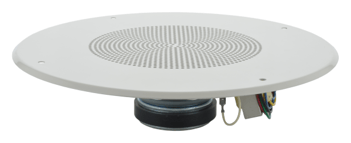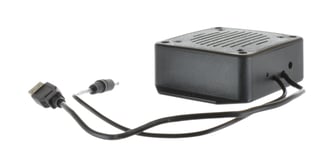High Voice Intelligibility Solutions for Audio Communications
“What was that?”
“What'dya say?”
You never want to be yelling that towards a loudspeaker—whether you’re in a drive thru line, waiting in a hospital emergency room, running through an airport, under the ocean in a submarine, or headed to the moon in the Orion space capsule. At the very least, an unintelligible speaker is frustrating; at the worst—like in an evacuation situation—it can be life-threatening.
Clear voice communication is one of the biggest expectations we have for the speakers we interact with every day. Creating a highly intelligible sound system doesn’t happen by accident, and a speaker that works well in one setting won’t necessarily meet the audio demands in a different location.
If you are working on how to communicate with people via speakers the first things you have to consider are:
- What space do you need to fill and what reverberant challenges will it create?
- How loud will you need the voice to be heard and what other noises will it be competing against?
Space and Volume Considerations for Intelligible Audio
The needs in a massive hospital wing versus what you have to get from the on-screen audio at a fueling station are very different and will inform all the design decisions that come next. Obviously, a paging system in a warehouse or the public announcement setup for a train station are both going to require multiple speakers. The size of a space, the shape of it, and the materials that make up the walls and ceilings all impact the acoustical properties of an environment. These data points will inform the number, size, and design of the speakers you’ll need.
As you start the process, begin by communicating with your speaker manufacturer as much detail as you can about the physical environment where the speakers will be placed. Their positioning will affect how sound waves reverberate off the various surfaces and what the resulting impact will be on the frequencies of a human voice.
This 20-page white paper on speech intelligibility in audio systems identifies ten primary and nine secondary impacts on how a system sounds. It points out that reverberation time (RT) will even impact how different words are heard. For instance, a word like “back” starts with a hard “ba” sound and then a softer “ck” sound. If the RT in a space is long enough and the reverberations are strong enough, that soft sound will get muddled, and “back” will be hard to distinguish from “bath,” “bat,” or any of a number of other words.
Carpet will absorb sound more than a hard flooring surface and high ceilings may give a space airiness, but space design choices like these impact sound design and they must be considered when designing your system.
Odds are, your speakers will not be the only things making noise either. It’s critical you consider the competing sounds–their volume and their frequencies. As a general rule of thumb, you will want your speakers to be 15-20 dB louder than the ambient sound in order for what is coming out of them to be plainly heard. An underpowered PA system may sound okay in an empty room but fail miserably as soon as that space is filled with people.
Along with the space considerations, you need to incorporate the distance from the speaker to the listener into your system design calculus. One of the most common reasons a PA system sounds bad is poorly locating the speakers relative to where the listeners are.
Will your speakers be near the low rumble of engine noises? Will they have to broadcast over background music? Or the high-frequency sound effects of a slot machine paying out? Each of these scenarios will create unique challenges that can be mitigated by the right choices in design and placement.
Intelligibility Band for Voices
Humans have evolved to have a good ear for voices. The frequency range we’re talking about here is called the intelligibility band and generally goes from about 125 Hz to 8 kHz. If you’re looking at a smaller space you may want to focus that down more to something like 250 Hz to 5 kHz.
The intelligibility band comes into play as you’re looking at the frequency response and resonant frequency of your voice speakers. Too much low frequency in a voice can make it sound garbled, and too much high-frequency emphasis can make it sound tinny and hard to listen to for any extended period of time. Designing a system to transmit just spoken words best will obviously come with some trade-offs like how paging systems generally don’t play background music very well. An audio setup expected to handle a mix of voice, music, and other sounds will sound best if it is a multi-speaker system (think of a home theater).
Voice speakers should be designed to have high-sensitivity and low-distortion qualities. These are parameters that you can establish and test for in a manufacturing setting. However, the true test of a voice-carrying sound system must take place where the speakers will actually be deployed. There are products and services that make it possible to test the speech intelligibility of a system, and a good speaker manufacturer will likely be willing to give you a prototype that can be tested this way.
Two measurement systems, STI (Speech Transmission Index) and STIPA (Speech Transmission Index of Public Address Systems) try to represent intelligibility with a single number. With STI you get a decimal between 0.00 (no intelligibility) and 1.00 (perfect speech intelligibility). A good system, even in a bad acoustical environment, can land in the 0.45 to 0.65 range. In an acoustically unfavorable room, that same system could reach 0.70 to 0.90 (which reinforces just how important understanding the space is to arriving at a good system).
Resource: White paper on setting up a speech intelligibility test
Ideally, if you communicated your needs well throughout the process and the speaker manufacturer listened and has the technical know-how, your speakers should be pretty close to what you’re looking for. With this, testing in the final environment should be not much more than a formality and an opportunity to make minor adjustments before the full system is installed.
If you have any questions about how to create an audio system that makes voices easily understood, we’re all ears. Please reach out to our team.



